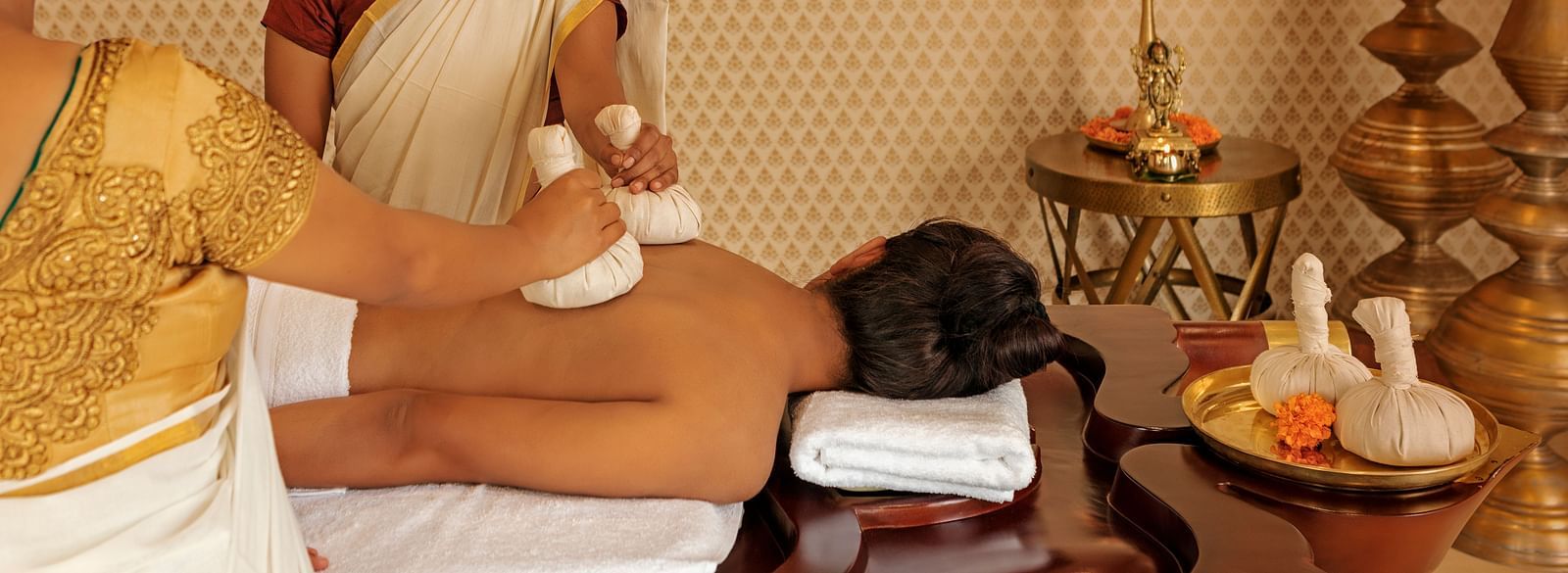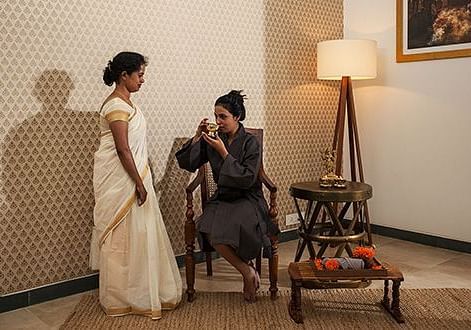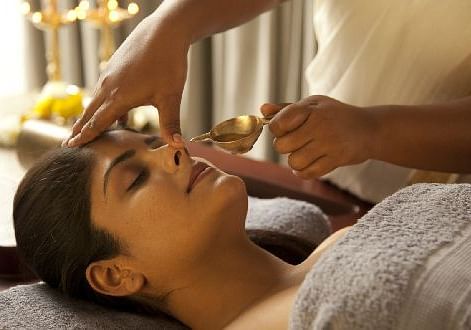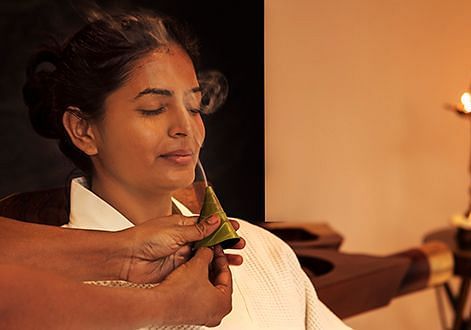Home > Holistic Health > Panchakarma

Panchakarma
Panchakarma, derived from Pancha (five) + Karma (action), is a five-fold regimen that uproots and expels the toxins embedded in the mind-body physiology. It is a process that goes deep into the body to purify. Like weeds, stress and toxins often entrench themselves deeply within our internal ecosystem due to the seasons of the year, our diet, external stressors, and more—leading to changes in the mind, body, and soul, causing dosha imbalance. The idea behind our Panchakarma treatment in Bangalore is to recalibrate the Vata, Pitta, and Kapha doshas back into equilibrium and to help us return to our natural state of well-being.
Panchakarma encourages total surrender to the healing process, eliminating toxins from the body and nurturing an internal environment where new and healthy tissue can regenerate.
The three elements of Panchakarma are:
- Poorvakarma—the preparation phase
- Pradhanakarma—the principal treatment
- Paschatkarma—the post-treatment phase

Poorvakarma
The first phase, Poorvakarma, is the foundation of the healing journey. Through three essential steps, it gently prepares the body for deeper cleansing by liquefying and releasing the morbid doshas, setting the stage for holistic rejuvenation.
Deepana-Panchana
Deepana-Panchana is performed by inducing internal medications, proper diet management, and certain external therapies. It is intended to increase the body's metabolic rate. This method is induced with the aim and objective of digesting and absorbing the partially metabolised end products in the human body and increasing the thermal rate. Through this, maximum bioavailability for medications can be achieved along with reducing multiple inflammatory changes present in the body. After completion of this treatment, it kickstarts the proper release of enzymes, increased peristaltic movements and enhancement of circulation in the body.
Snehana
Ayurvedic Oleation techniques are administered both internally and externally with the objective of ensuring proper movement of doshas by making them more fluid in nature. Medicated edible oils or ghee are used for Snehana therapy, which is either administered internally or massaged into the skin. This stimulates the release of toxins trapped within. Our experienced physicians will guide you on precise Oleation techniques after body analysis.
Swedana
Swedana is a series of hot fomentations made with Ayurvedic herbs. They are administered after the Oleation process as they soften and melt down the toxins stored in the body so that they can be expelled easily during the purification process. Once the body has been well prepared during the Poorvakarma stage, the Pradhanakarma (principal procedure) can begin. These are the primary procedures by which the toxins will be eliminated from the body completely, and there are seven distinct processes.
Pradhanakarma
Once the preparatory therapies have loosened and mobilised the toxins, the core procedures commence, focusing on cleansing the body of impurities. The Pradhanakarma treatments are then administered, each one meticulously designed to restore balance and vitality to your body.

Vamana
The role of Vamana is to balance out the Kapha Dosha. An Ayurvedic doctor will induce emesis (vomiting) with a herbal tonic to eliminate kapha toxins from the body. This helps in detoxifying the upper respiratory tract, thereby clearing respiratory pathways. It also enhances mental clarity along with improving metabolism.
Virechana
Virechana focuses on balancing the Pitta Dosha. A herbal tonic is administered that catalyses the downward expulsion of toxic matter through the alimentary canal and out through the anal region. This is a controlled cleansing of the bowels which helps in detoxifying the digestive system. This karma helps in purifying blood and skin as well as providing emotional balance.
Vasthi
Vasthi focuses on all three doshas—Kapha, Pitta, and Vata. Vasthi focuses firstly on the Vata Dosha. By treating the Vata Dosha, all the remaining doshas and dhatus get streamlined. Vasti is a herbal enema that is administered through the anorectal region. The purpose of the Vasthi is to activate (stimulate) the sympathetic and parasympathetic nervous systems. It is also helpful in alleviating several inflammatory conditions, which in turn brings the body into a state of equilibrium.
Asthapanavasthi/
Niruhavasthi/
Kashayavasthi
We induce excretion with a decoction of herbal pastes, oils, milk, and honey to purge (eliminate the toxins while also treating certain health conditions) the digestive system completely. This treatment will not only expel the toxins in the system but also improve your metabolism, enhance vitality, and help in treating diseases. It improves digestion and peristaltic movement. It is one of the key procedures in the Panchakarma process.
Anuvasanavasthi
Anuvasanavasthi is a counteractive process. Medicated oil and ghee are blended with herbs and administered through the ano-rectal region. It helps to mitigate the effects of toxic expulsion on the rectal opening. Majorly intended for balancing Vata Dosha, this treatment helps in nourishing body tissues and lubricating intestinal lining along with enhancing nerve functions.
Nasyam
According to ancient Ayurveda, the nose is the source of life. It is believed to be the gateway to the brain; Nasahi shirasa dwaram. During the Nasyam procedure, a blend of herbal powders, leaf extract, and oil or ghee is administered through the nostrils. It helps in cleansing organs situated above the clavicle bone to clean out the nasal tract and enhances our sense of smell. Nasyam is both a preventive and a curative procedure. It rejuvenates the nervous system and prevents premature greying of hair and ageing.
Raktha Mokshanam
This process is used to treat blood and Pitta-related diseases to clean and purify the blood. It translates to 'bloodletting'. Releasing blood from the blood vessels, veins, and arteries serves to detoxify the body at its most fundamental level. While the traditional methodology involves leeches, needles, blades, and cups being placed on various parts of the body, there are several other sanitary ways to carry out the practice as well. Our Ayurvedic doctors will gauge whether this procedure is required for you based on your strength, age, the weather, and the degree of impurity in the blood.

Paschatkarma
Paschatkarma is the restorative phase. During this series of treatments, your body rests and recovers from the intensity of the main treatment. It allows the body to truly absorb the benefits of the treatment. Meditation, oil massages, pranayama, and yoga open and rejuvenate the energy channels of the body, mind, and soul. Each procedure of the Pradhanakarma has a corresponding process in Paschatkarma.
Paschatkarma for Vamana and Virechana
Samsarjana Karma focuses on your diet. Vamana and Virechana have an intense impact on the internal lining of your digestive system. Samsarjana Karma advocates a special dietary regime for three to seven days after the main procedure. Light, wholesome, and easily digestible, the food must be freshly prepared with no spice to catalyse your digestion and prevent impurities from accumulating in the body.
Paschatkarma for Vasthi
After Vasti treatment, one should immediately take a warm, soothing bath and a lot of rest. You will be given an extremely simple diet of boiled lentils and gram. For a certain length of time, known as Parihara Kaala, you will have to follow a restorative regimen in which there can be no physical or emotional stress. One must stay out of the sun and avoid eating spicy, pungent, or fried foods. Stale foods and excessive eating should be avoided at all costs.
Paschatkarma for Nasyam
After Nasyakarma, a medicated smoke inhalation (Dhoomapana) is administered to clear any residual oil or mucus from nasal passages. This is followed by warm water gargling (Kavala). A gentle face steam and face massage ensure muscle relaxation and enhanced circulation.
Paschatkarma for Raktha Mokshanam
After Raktamokshana karma, primary care is to manage bleeding and wound management. The wound is washed with Ayurvedic antiseptic liquids, and then herbal healing pastes are applied. In the case of leech therapy, the part of the body is cleaned with saline solution and bandaged after sprinkling turmeric powder on the site.